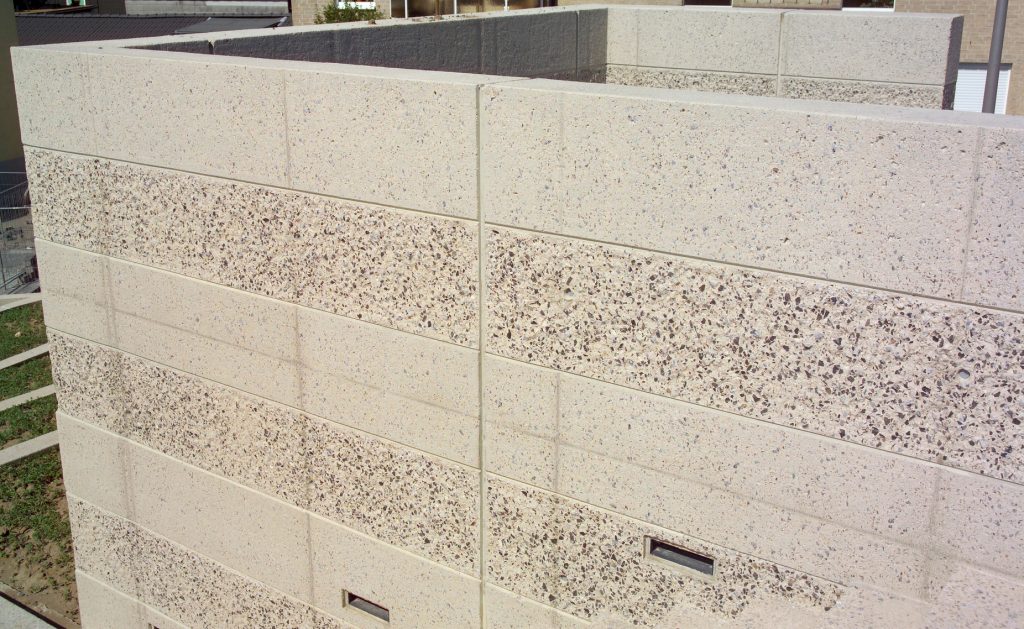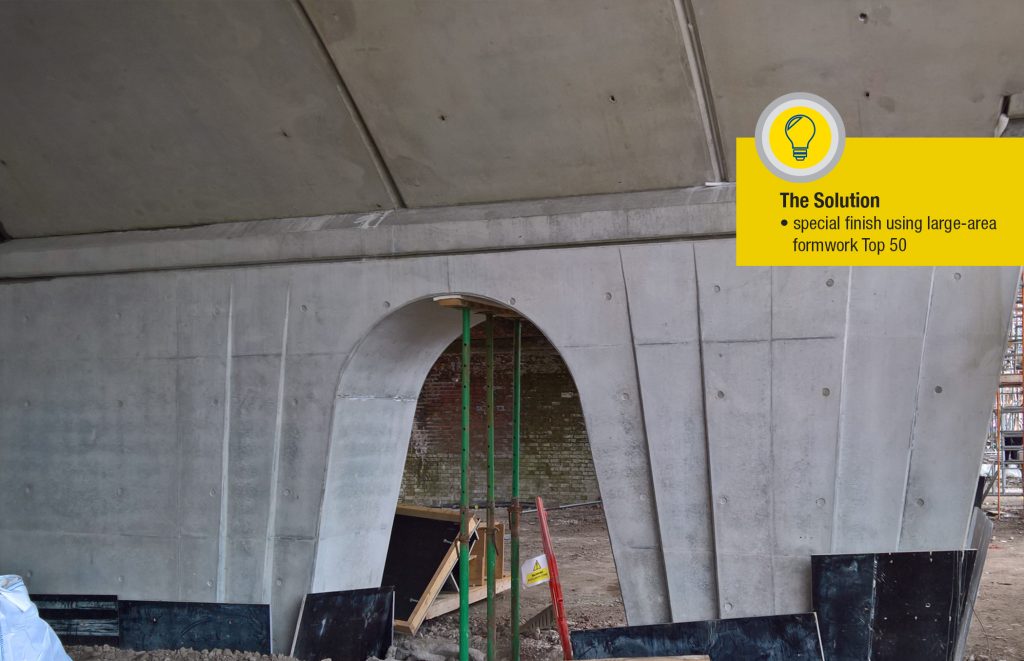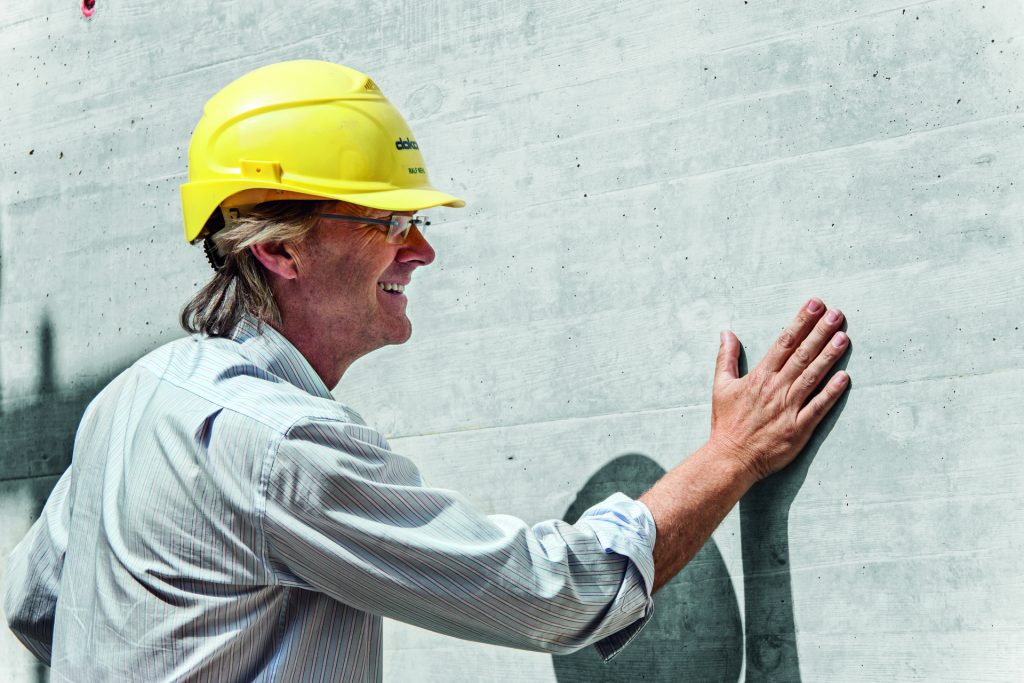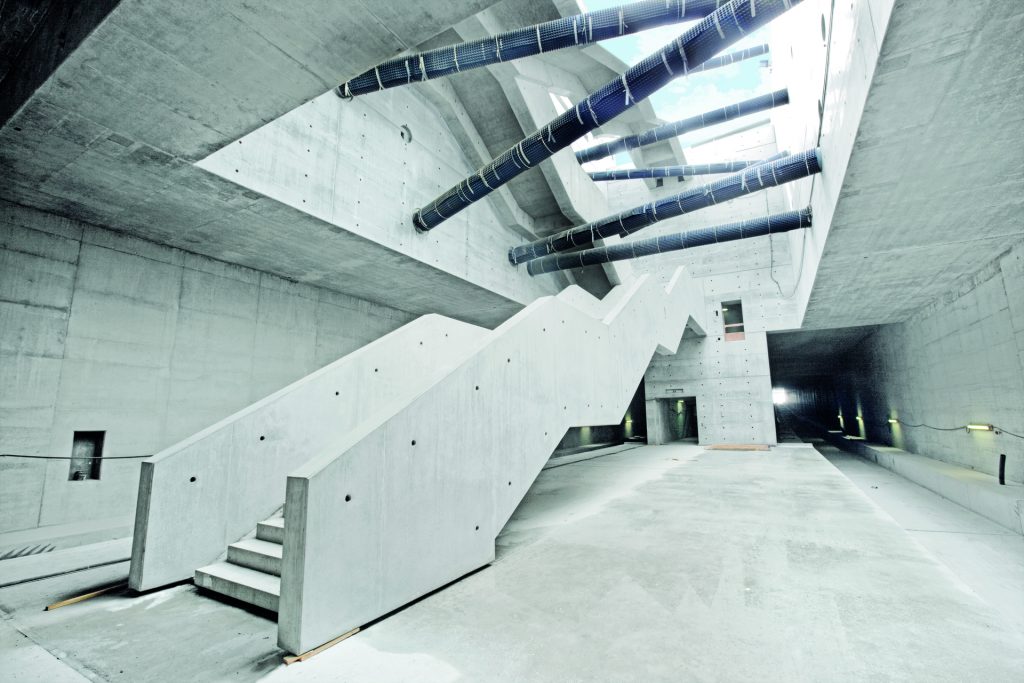Doka UK 12 August 2019.- A clear trend is ‘surfacing’ in the language of architecture, towards concepts that are as individual as they are unique. Buildings are being asked to convey interesting forms of expression both inside and outside in an attempt to not only provide functional spaces but also social and visually appealing places to be. Cast-in-place concrete can create this extra flexibility for architecture when required, but it takes some planning to achieve the vision of all involved. Whether this be for the construction of bridges, tunnels, stadiums or high-rise buildings, every project is unique and with this comes the formwork solution and the concrete finish. In this article we delve into this topic, with reference to Doka’s competencies in this specialist area.
It is important to understand that each project is unique and with this, requirements for architectural concrete solutions need to be customised and matched to each concrete element and to the requirements of each structure. Helping support in the selection process, the greatest results arise from close collaboration amongst all stakeholders involved in the construction process – from contractors to architects and also the formwork supplier. Doka’s team of experts support this process from the early consulting pre-construction stage all the way through to completion and sign-off.
What are concrete finishes?
There are various types of concrete surface finishes achievable and which can be considered for those working with in-situ solutions specified by the building stakeholders. With reference to Construct, the Concrete Structures Group and a cement and concrete industry publication ‘National Structural Concrete Specification for Building Construction’ (NSCS) published by The Concrete Centre, we discuss concrete finishes in further detail.
Specification and standards
In regards to specification and standards, BS EN 13670: basic, ordinary, plain and special has now replaced BS 8110: Finish A, B & C with finish classes 1,2 & special. The National Structural Concrete Specification (NSCS) has the same scope as BS EN 13670 for building structures and the NSCS covers requirements for the construction of concrete building structures, which includes in-situ concrete amongst others. Further information can be found in the Concrete Society Publication “Formwork, a guide to good practice” 3rd edition and an additional publication “TR52 Plain Formed Concrete Finishes”.
Types of surface finishes
For civil engineering and infrastructure projects, there are two specific guides which are alternative to those for typical building requirements. These two specific guides are the Specification for Highways Works – Class F1 to F5 and Special; and the Civil Engineering Specification for the Water Industry (CESWI) – Rough, Fair and Fair Worked.
In normal concrete frame and building applications, a plain finish is where the visual effect is of some importance, whereas for a special finish, specific requirements will be given. Examples of plain finishes include areas only seen occasionally or areas which are prepared, this also can include direct painted areas where there are some particular requirements. Whereas a good example of a special finish would be an area where surface regularity and / or colour are important factors. Below we list four main types of formed finishes taken from the fourth edition of National Structural Concrete Specification for Building Construction.
Basic finish:
There are no requirements for this type of finish other than to enable adequate compaction, to provide adequate cover to reinforcement and to achieve specified tolerances.
Ordinary finish:
There are no special formwork requirements for this finish. Concrete should be thoroughly compacted and the formed surface should be free from major inherent blemishes and honeycombing. There is no requirement for consistency of colour for the struck surface.
Plain finish:
A plain concrete finish requires the careful selection of concrete, release agent, and the use of good quality formwork. The concrete must be thoroughly compacted and all surfaces should be true with clean arises. Only very minor inherent surface blemishes should occur, with no discolouration from the release agent or grout runs from adjacent pours. The struck surface should be of a consistent colour from the materials used. The arrangement of formwork panels and tie-bolt holes should be in a regular pattern. Steps at joints between forms to be a maximum of 3 mm.
Special finish:
A special finish often referred to as visual or architectural concrete, requires the careful selection of the concrete, release agent, the use of good quality formwork and thorough compaction. Detailed requirements of the surface finish required, and any permitted further working or improvements to the as-struck finish are given in the NSCS project specification.
Below we list specification considerations for producing special finishes:
- Required surface regularity must be achievable
- Allowable colour variation of the surface based on generic colour of the concrete
- Extent of acceptable blowholes. These depend on formwork type, concrete, release agent and compaction – some blowholes are inevitable
- Structure edges required
- Use of cover spacers
- Arrangement of formwork joints and tie holes (filled but ideally left recessed)
- Location of ‘sample’ or similar finish
- Special tolerances – must be achievable. Give consideration to manufacture tolerances, material behaviour and build tolerances
- Light reflectance
The NSCS suggests that the following issues should be considered when producing a special finish:
- Early discussion and teamwork between the architect, engineer and constructor to ensure understanding of the project finish required.
- Particular care in the choice of materials, for both formwork and concrete, good site care and satisfactory supervision of the work.
- Site practice – formwork – surfaces should be protected (i.e. from rainwater damage, not to be left flat on the ground, plywood to be cared for.
- Site practice – concrete – the use of trials is strongly recommended where a particular appearance is envisaged. These trials should be performed under the same circumstances and conditions of the later real casting. This includes but is not limited to the same or similar weather conditions, the same temperatures and the same team on site.
- Colour is partly dictated by the smallest particles in the concrete, that is mainly cement and to a lesser extent the sand. The course aggregate has little effect on the colour. The addition of ggbs makes the finish lighter, while fly ash makes it darker. If cement replacements are used at a high ratio compared with cement volume then this can have an impact on the setting times of the concrete and generally increases the concrete formwork pressures and potentially the costs of the formwork. Very white concrete requires white cement, silver sand and sometimes white pigment which are difficult to source in the UK. It is possible to produce a ‘whitish’ concrete using a high proportion of ggbs and suitable sand at a much reduced cost. In addition, concrete maturity can have a big impact in this area, and is discussed later in the article. Coloured concrete is also best produced using white cement, as the results of the colours will appear more saturated.
- Materials – for ready-mixed concrete these will generally be dictated by what is available at the plant as any variation in materials is difficult to organise as it involves cleaning out supply hoppers. Therefore if a concrete using particular materials has been identified as giving the colour needed the supplying plant may need to be specified. When the materials have been determined no changes must be made to the mix proportions or water/cement ratio as even small changes in water content can alter the final colour.
- Trial panels – these are best done full size in a location where surface finishes may not be as critical, for example, basements. They should include reinforcement, details of all expected joints and features, and use the proposed methods for concrete placing, compacting, etc to allow an assessment of the formwork quality, placing methods and other procedures. At Doka, we would recommend purposely including some planned faults within the trial panel (in arrangement with all parties) so that agreement can be made on what is and isn’t acceptable and agree what measures are necessary to rectify works if required.
- Concreting should take place as soon as possible after fixing the reinforcement to minimise the risk of rust stains from the rebar getting onto the shutters and then being absorbed into the finished concrete surface.
- Post-concreting – the time to strike should be kept constant at about 24 to 36 hours, to minimise the risk of discolouration from the release agent or formwork. Consistency in striking time can keep the colour consistent, however it is not specifically about the time elapsed, but the concrete temperature evolution and resultant maturity which has one of the most important influences here as is discussed in more detail later in the article.
Considerations when special finishes (visual and architectural concrete) are required
The quality of formwork and joinery will have a major influence on the quality of the concrete finish. It is essential that the formwork is robust and well constructed and does not overly deflect during concreting. The design of the formwork support is therefore essential in getting a good visual concrete finish. All joints must be, as far as possible, grout-tight – careful detailing of joints and corners can help in getting grout-tight joints.
Formwork face selection:
It is important to understand the form face qualities that are required for your in-situ areas on site, as this will effect which material that you should use – in particular the type of plywood sheet selected. There can be colouration differences between first and second pours due to increased absorption of the face material for first use. To minimise possible variations, Doka recommend pre-grouting the plywood prior to carrying out the first pour (in particular for phenolic faced plywoods). The need to pre-grout is minimised for MDO plywoods as these tend to produce more even results. In addition to this, it is recommended to pre-grout individual plywood sheets when replacing part way through projects. You will also need to consider the number of uses required, in addition to the cost, quality, finish, shapes and relationship with the release agent. In one of our future blog articles ‘selecting the right plywood can help achieve the right concrete finish and save costs on site’ will discuss this particular topic further. Subscribe here to receive regular blog updates from Doka.
Doka formwork & falsework systems
Doka offers fast and efficient formwork and falsework systems which, through early pre-construction consultation can help projects achieve the required finish specified by utilising the most appropriate options available. For example, Doka’s high-grade plywood sheet Xlife is a high-grade plastic/wood composite sheet with hard-wearing plastic coating for a significantly longer lifespan and uniform concrete faces over a long time of service and can be used for horizontal and vertical formwork applications. For more daily use but high specification finishes Dokaply Birch may also be a good alternative cost effective option.
Below are just a few examples of where Doka customers have benefitted from the expertise in architectural concrete finishes through different finishing processes and concrete mixes to give a variety of textures:


Factors that can influence formwork costs for concrete finishes
Below we discuss factors which can have a major influence on the costs associated with formwork when considering the options including the different approaches and systems:
- Rental costs: For some architectural features it may be possible to use standard equipment configured or pre-assembled in order to achieve the desired finish but in other instances it may be that completely bespoke steel or wooden formwork solutions are required to be constructed. The cost of these two options would vary considerably and so alternative options should be fully considered as part of the planning.
- Operations scheduling: Formwork for special projects typically require longer planning and production times.
- Freight: The volume of traditional timber beam formwork is generally larger than that of systemised panel formwork. It can also be noted that pre-assembly offers the combined benefits of quality and accuracy of build and cost assurance. However, off-site assembly commonly increases the transport costs versus supplying individual components.
- Assembly: Planning is often required to assemble certain elements off-site in order to achieve the required finish, minimise labour on site and work within often constrained building site footprints.
- Material selection: Costs of fair faced concrete finishes will likely require additional or higher specification materials, such as superior plywood or additional lining.
Colour consistency and the importance of concrete maturity
Often, one of the major considerations alongside the finish look and feel is the colour consistency between casting steps on site. What you may not have previously been aware of is that the concrete maturity itself has a major impact on achieving this consistency in colour. By striking the concrete at a specific concrete maturity then the chances of achieving consistency are greatly improved. Maturity can be affected by many different factors – some of these include the method chosen, the ambient temperature, weather conditions, release agent, the concrete mix amongst other factors.
The use of concrete maturity measurement tools such as Concremote from Doka, allows the contractor to see what the maturity level the concrete has reached inside the formwork, with live information being sent from sensors to the user via the mobile telephone network. Using the information, the contractor can plan and know the best time to strike the formwork and move to the next pour. This also enables the contractor to plan time for labour and other activities more effectively.
Concrete selection
Section 8 of the NSCS – ‘concrete and concreting’ acknowledges that concrete has a dual strength classification, for example C28/35 to allow for both cylinder and cube strengths. The second number is the cube strength. It is important that full classification is to be given to avoid misunderstanding.
BS 8500 covers the selection of concrete and cover to reinforcement to suit design exposure conditions. There are six exposure classes to BS EN 206-1:
- No risk of corrosion or attack (XO)
- Corrosion induced by carbonation (XC)
- Corrosion induced by chlorides other than from sea water (XD)
- Corrosion induced by chlorides from sea water (XS)
- Freeze/thaw attack (XF)
- Chemical attack from natural soil and groundwater (XA)
The concrete selected for any application must be suitable for all the applicable exposure classes as there can be more than one at any one location or for any one element. It is important to define your concrete mix when considering the required finish as visually appealing concrete requires a slightly different ‘recipe’. The Concrete Centre also state that a high percentage of cement replacement impacts early strength gain.

Helping UK infrastructure projects achieve architectural finish
Doka have assisted in the implementation of fair-faced concrete for a variety of projects worldwide. In this instance, we take The Northern Hub project as an example. A new, faster rail link for the north of England was the objective of the project. Based in Manchester, specific elements of the masterplan required a special concrete finish specified by the client and architect. Doka provided custom formwork solutions for the complex design of a section of 20 viaduct piers in total, which had different geometries to match the existing Victorian brick built piers. By using Doka’s pre-assembly service, this gave the customer the additional benefit of speeding up work routines by delivering the assembled formwork ready-to-use to site. A high quality, special concrete finish was required where no ties were allowed into the existing brick piers. The risk of undesirable side effects caused by chemical and physical interactions (e.g. release agents, concrete additives) between individual material components during construction was diminished as the customer carried out advance testing of interactions between the materials through carrying out sample pours. This ensured that the quality of the project finish was to the high standard required.

As mentioned on our web page ‘8 tips for high-quality architectural concrete’, we recommend to select the most suitable formwork system for the project as the formwork system plays a major factor for the concrete finish. The arrangement of the form ties and the footprint made by the panels at the inter-panel joints will subsequently appear on the surface, patterning the visible part of the concrete. In this instance, The Northern Hub opted for large-area formwork Top 50.


Sources:
- Construct, the Concrete Structures Group
- National Structural Concrete Specification for Building Construction published by Construct, the Concrete Structures Group







